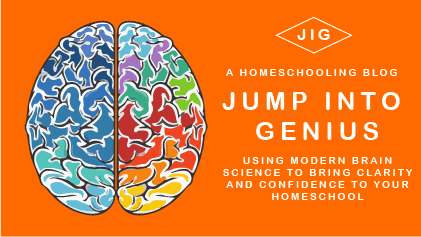My 5th grader had blasted through his long division problems. But they were all wrong. He had clearly forgotten the steps to solving long division problems. Again. Why?
Soon doubt was knocking at my front door as I wondered if I was part of the problem. Did I completely suck as a teacher? Could someone else do a better job? It seemed like such a simple concept to teach, yet his lack of understanding and remembering made me feel like a complete failure. And as doubt crept in, I felt the my energy seeping out of my body, as if I was a tub, and someone has just pulled up the plug.
Doubts about our own ability to teach visit us often in our homeschools. But we can’t afford to let doubt stay, because of it’s energy sucking powers, we just can’t have an amazing homeschool and be wracked with doubt. We have to choose one or the other. Kicking doubt out of the house takes a lot of energy and determination, but a little knowledge is just the weapon you need to get this nasty critter off your turf.
But understanding not only how kids learn, but also how to learn to become a better teacher, can both make those dates with doubt less frequent. And keep extended vacation plans with you and doubt out of the question.
Table of Contents
Teaching is a cognitive skill
The teaching brain has a lot in common with the learning brain. They both need space in working memory and to support that space they need background knowledge so they can take advantage of long-term memory and automaticity. Teaching is a cognitive skill. One of the main differences between a teacher’s brain and a student’s brain is the amount of background knowledge. Teachers need a high level of knowledge in the subject matter being taught and also a rich store of information about how to teach that knowledge.
(You are reading the ninth and final post in a series about cognitive science in your homeschool, click here for the introductory post and links to the other posts in this series.)
Great teachers are constantly learning
A good teacher must always be learning. Learning subject matter and learning how to teach that subject matter. Learning about themselves and how they can improve their teaching skills.
In addition to constantly learning, great teachers have just two things in common with other great teachers. They organize material like an expert, and they emotionally connect with the kids they are teaching.
Make the curriculum be the subject matter expert
How can homeschooling moms hope to become an expert at teaching every grade and every level? One way to ease the pain is by focusing on principles of teaching and learning how kids learn.
Then make the curriculum be the subject matter expert. Make sure any curriculum you buy is written by expert teachers who understand not only the subject but how to teach it well. They need to understand how kids at that age think and what assignments fall within the realm of reality. What can a kid that age typically understand, and how does the information need to be presented for them to be able to understand it?
So you can be the expert on connecting with your kid
Become an expert on what works in your home, what works for your child, and what is expected/typical behavior and development for kids the same age as yours. The subject matter expert doesn’t know your kid. They don’t know how much or little repetition is needed for them to learn. They don’t know if it is better to use comprehension questions as verbal conversation starters or written answers. They cannot guess if the child will need to fill in some general background information gaps before they can understand the new concepts.
In short, they have to guess about what your kid needs. Because all they know is their subject. But they know it really well. And if you know your kid really well, then the two of you can make an amazing team.
How to Actively Practice Becoming a Better Teacher
- Keep a journal. Takes notes about what works for your kids, what doesn’t. What assignments do they struggle with?
- Think about video recording a part of your day that constantly collapses. Does math always turn into tears? Record the lesson, both yourself and your child. Watch it later and observe. Try to be impartial. A frustrated child cannot learn, the upset emotions turn off the learning brain. Whatever you think your child should and could do needs to take second place to what your child actually CAN do and not only that but what they can do without it being so hard they collapse into an emotional mess.
I am not saying you can’t push them. But when you push them too far, they will actually stop learning. You have to find the sweet spot of pushing them just enough that they are learning at a good clip and not so much their brain shuts off.
- When you have ideas about what to change, choose just one. If your video and journal are revealing your own week points, choose one small thing to change, and remember to record the results. Did that change have any effect? Write down your ideas of what needs to change and then pick just the most important one to implement first. Once you are confident in your ability to stick to that change you can add the next thing on your list.
This method will keep you from being overwhelmed. It will keep consistency in your home, which is very important for your kids. When kids know what to expect and what is coming next they are more confident and calm. You may also realize as you work through your list, that you really only need to change three small things. When we change too much at once we have no way of telling what actually helped. One small change at a time will reveal which changes were the magic bullet.
As teachers, one of our biggest, most important, and hardest jobs is finding balance. We have to find balance in our own lives. Balance in our knowledge, filling in areas where we are lacking. Balance in what and how we teach. Figuring out how to balance all these things is an intense game of cognitive juggling.
Our working memories spend a lot of time being used a maximum capacity. To balance that demand, we must also rest. As teachers we set the tone for our students, only if we have achieved internal balance can we hope to maintain external balance in the classroom and the home.
In the End
So that 5th grader learned his long division steps. It took longer than I expected. It took longer than he wanted. It took a shift in his own motivation. But in the end both my son and I learned a lot as we walked along the long division path together.
He learned I would never stop believing that he could do it. He learned that his mom would never let him slack off because she new he was smart, even when he didn’t think he was smart. He learned he was smart. He learned that trying, and caring, and putting in a little work could work magic.
I learned that he didn’t need fancy teaching tricks or any bells and whistles. He just needed to sit down every day, pay attention, and do it, until it was easy. No magic was going to make it easy. Only putting in the time and effort was going to make it easy. I learned that time and effort are magic. I learned that one of the most powerful and important jobs I have as a mom is to never stop believing in what I know about my kids.
Because sometimes everyone else on this planet will be blind to the gems buried inside your kids. Even our kids themselves don’t know they are full of those gems, until their mothers love, her ferocious, stubborn determination, her tears, wash away the dirt so the child, and the rest of the world, can see those gems.
Now he is a senior in high school and is not just getting into colleges, he is earning large academic scholarships. Not because he is an academic kid. But because he found out all he needed to do to be smart was work a little harder for a little bit longer and care just a little bit more.


